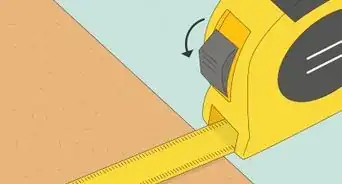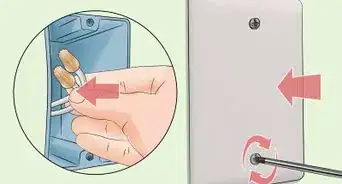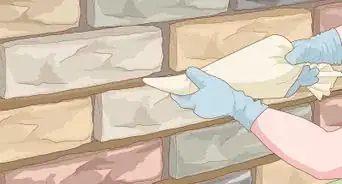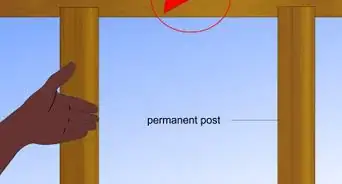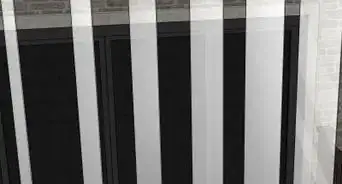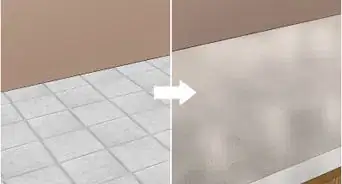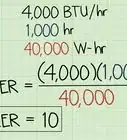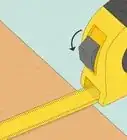This article was co-authored by Mark Spelman. Mark Spelman is a General Contractor based in Austin, Texas. With over 30 years of construction experience, Mark specializes in constructing interiors, project management, and project estimation. He has been a construction professional since 1987.
wikiHow marks an article as reader-approved once it receives enough positive feedback. This article received 20 testimonials and 84% of readers who voted found it helpful, earning it our reader-approved status.
This article has been viewed 1,735,729 times.
Knowing how to measure square footage can be very useful for real estate rental and sale purposes, and it can also help you ace your next geometry test. To measure the square footage of a space, separate the space into manageable parts, find the square footage of all those different parts (usually by multiplying length times width), and add the square footage of all separate parts together to find the square footage of the overall space.
Steps
Find the Square Footage of a Space
-
1Break down the area into manageable parts. If you're having trouble finding the square footage, then it's probably because you're not working with a neat area with just one length and one width. The space might have squares jutting off in different places and could be shaped erratically. All you have to do is split up the space into even squares or rectangles. To find the square footage, or the area, of the entire space, you'll need to find the square footage of the individual spaces and then add them all together.[1]
- Draw faint lines separating the different sections.
- Label them A, B, and C for your convenience.
-
2Measure the length and width of the first space. Using a ruler or measuring tape, find the length and width of the first space you've created, Space A.
- The length of the space is 12 feet (3.7 m), and the width is 15 feet (4.6 m).
Advertisement -
3Multiply the length of the first space by the width of the first space. To find the square footage -- or the area -- of the space, just multiply the length times the width, just as you would do with any rectangle.
- Ex: 12 feet (3.7 m). x 15 feet (4.6 m). = 180 square feet
-
4Measure the length and width of the second space. Let's say that the length of Space B is 20 feet (6.1 m) and the width of Space B is 10 feet (3.0 m).
-
5Multiply the length of the second space times the width of the second space. This will lead you to find the square footage of the second space.[2] Here's how you find the square footage of Space B:
- Ex: 20 feet (6.1 m). x 10 feet (3.0 m). = 200 square feet.
-
6Measure the length and width of the third space. Let's say that the length of Space C is 20 feet (6.1 m) and the width of Space C is 35 feet (10.7 m).
-
7Multiply the length of the third space times the width of the third space. This will lead you to find the square footage of the third space. Here's how you find the square footage of Space C:
- Ex: 20 feet (6.1 m). x 35 feet (10.7 m). = 700 square feet
-
8Add the square footages of the three spaces. Once you find the sum of the square footages of the three spaces, you'll know the square footage of the entire space. Here's how you do it:
- Square footage of Space A + square footage of Space B + square footage of Space C = square footage of the entire space
- 180 + 200 + 700 = 1080 square feet
Learn a Few Tricks for Finding Square Footage
-
1Find the approximation of square footage. If you're looking for an approximation of square footage, you can also try measuring the outside of your home and then subtracting any areas that won't be factored in to the square footage, such as the porch stairs or garage.
- Ceiling and floor tiles are often one square foot in size. You can simply count these to get a close approximation of the total square footage.
-
2Find the square footage of a space that's shaped like a half-circle. If there's a part of your house that's shaped like a half of a circle, you can find the square footage of the circle by finding the area of the space as if it were a full circle and then dividing it by half. To do this, simply measure the long line that cuts the "circle" in half to get the diameter.[3]
- Next, divide that number by 2 to get the radius (r) and plug the result into the equation A = πr2.
- Finally, divide by 2 to get the area, or square footage, of the half circle.
-
3Find the square footage of a space that's almost regularly shaped. If you're measuring a space that is almost fully a square or a rectangle, with only a small square or rectangular part missing, then measure the square footage of the entire space as if the missing part was filled in. Then, find the square footage of the missing part and subtract it from the overall square footage to find the square footage of the space. This will save you time.
Expert Q&A
Did you know you can get expert answers for this article?
Unlock expert answers by supporting wikiHow
-
QuestionWhat is the square footage of a house 30 by 24 ft?
 Mark SpelmanMark Spelman is a General Contractor based in Austin, Texas. With over 30 years of construction experience, Mark specializes in constructing interiors, project management, and project estimation. He has been a construction professional since 1987.
Mark SpelmanMark Spelman is a General Contractor based in Austin, Texas. With over 30 years of construction experience, Mark specializes in constructing interiors, project management, and project estimation. He has been a construction professional since 1987.
Construction Professional
-
QuestionAfter I get the square footage, how do I figure how many boxes of flooring it would be?
 Mark SpelmanMark Spelman is a General Contractor based in Austin, Texas. With over 30 years of construction experience, Mark specializes in constructing interiors, project management, and project estimation. He has been a construction professional since 1987.
Mark SpelmanMark Spelman is a General Contractor based in Austin, Texas. With over 30 years of construction experience, Mark specializes in constructing interiors, project management, and project estimation. He has been a construction professional since 1987.
Construction Professional
-
QuestionWhen buying a house is the square footage advertised based on outside measurements or inside measurements?
 Mark SpelmanMark Spelman is a General Contractor based in Austin, Texas. With over 30 years of construction experience, Mark specializes in constructing interiors, project management, and project estimation. He has been a construction professional since 1987.
Mark SpelmanMark Spelman is a General Contractor based in Austin, Texas. With over 30 years of construction experience, Mark specializes in constructing interiors, project management, and project estimation. He has been a construction professional since 1987.
Construction Professional
References
About This Article
To measure square footage, start by dividing the space you're trying to measure into even squares and rectangles. Then, measure the length and width of each individual square and rectangle. Next, find the square footage of each square and rectangle by multiplying its length by width. Finally, add up all the individual square footages to get the square footage of the entire space. To learn more from our Contractor co-author, like how to find the square footage for oddly-shaped rooms, keep reading the article!

